In recent years, the concept of regenerative farming versus conventional farming has gained significant traction in the world of agriculture and food production.
With increasing concerns about soil health, climate change, and the sustainability of conventional farming practices, regenerative agriculture has emerged as a promising solution.
So promising that I believe regenerative farming is the future of agriculture.
But what does regenerative farming mean and why should it matter to everyday food consumers like you and I?
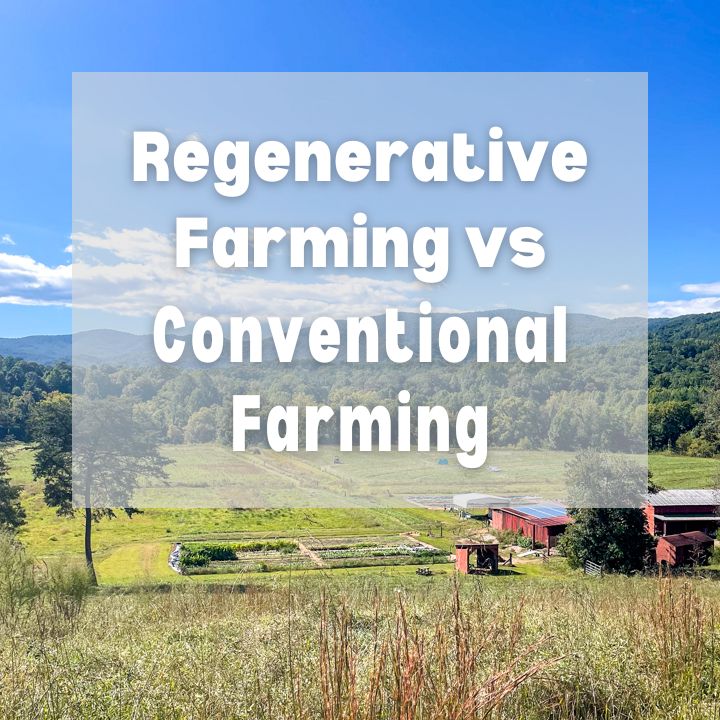
Regenerative Farming vs Conventional Farming
Regenerative farming and conventional farming are two fundamentally different approaches to agriculture, each with its own set of practices, goals and philosophies.
Fundamental to regenerative farming is healthy soil.
Regenerative farmers recognize that soil is not merely a medium for plant growth but a complex, living organism. These farmers understand that the health of the soil is intricately connected to the health of plants, animals, and even humans.
This fundamental understanding forms the basis of regenerative farming practices. In other words, regenerative farming prioritizes soil health above all else.
Regenerative farming prioritizes soil health above all else.
Unfortunately, decades of conventional farming practices have taken a toll on the health of our soils. Soil erosion, depletion of organic matter, and the heavy use of chemical fertilizers have degraded soil quality in many agricultural regions.
Let’s take a brief look at some key differences between regenerative farming and conventional farming.
Regenerative Farming
- Soil Health: Regenerative farming places a strong emphasis on improving and maintaining soil health. Practices such as no-till farming, cover cropping, and composting are used to enhance the health of the soil, increase organic matter, and promote beneficial microbial activity.
- Biodiversity: Regenerative farming encourages biodiversity both above and below the ground. This includes crop rotations, planting cover crops, and preserving natural habitats for all sorts of living creatures.
- Chemical Use: Regenerative farming seeks to minimize the use of synthetic chemicals, such as pesticides and fertilizers. Instead, it often relies on natural solutions, like biological pest control and nutrient cycling.
- Carbon Sequestration: One of the key goals of regenerative farming is to sequester carbon in the soil. Healthy soils can help mitigate climate change by drawing down atmospheric carbon dioxide and storing it in the ground.
- Ecosystem Resilience: Regenerative agriculture aims to create resilient ecosystems that are less susceptible to pests, diseases, and extreme weather events. Healthy soil and diverse landscapes contribute to this resilience.
- Holistic Approach: It takes a holistic approach to farming, considering the entire ecosystem and the long-term sustainability of the land. Farmers often work in harmony with nature.
Conventional Farming:
- Tillage: Conventional farming typically involves extensive tilling (plowing) of the soil to prepare it for planting. This can lead to soil erosion, loss of organic matter, and degradation of soil health.
- Monocultures: Conventional farms are often monocultures, where a single crop is grown over a large area. This can lead to increased pest and disease pressure and may require more chemical inputs.
- Chemical Inputs: Conventional farmers rely heavily on synthetic chemicals, including fertilizers, pesticides, and herbicides, to maximize crop yield and control pests.
- Carbon Emissions: The use of fossil fuels in conventional agriculture, along with soil degradation, can contribute to greenhouse gas emissions rather than carbon sequestration.
- Short-Term Focus: Conventional farming tends to prioritize short-term gains in crop production and profit, often at the expense of long-term soil health and environmental sustainability.
- Reduced Biodiversity: The focus on monocultures and chemical inputs leads to reduced biodiversity on and around conventional farms.
In summary, regenerative farming prioritizes soil health, biodiversity, and ecosystem resilience while minimizing chemical inputs and carbon emissions.
Conventional farming, on the other hand, often relies on intensive tillage, monocultures, and chemical inputs to maximize crop yields in the short term.
With that, let’s take a deeper look at the principles of regenerative agriculture and why I believe it is the future of farming.
12 Regenerative Farming Practices
I recently had the opportunity to spend two days touring small farms in North Carolina. I got see and learn first hand how farmers are using regenerative farming practices to improve the soil, grow food and raise livestock.
These regenerative farming practices include: incorporating livestock, keeping the soil covered, fostering diversity and reducing or eliminating tillage.
At its core, regenerative agriculture seeks to do no harm and actively improve the land. It’s an audacious calling and farmers all around the world are stepping up to the plate.
1. Put Animals Back on the Land
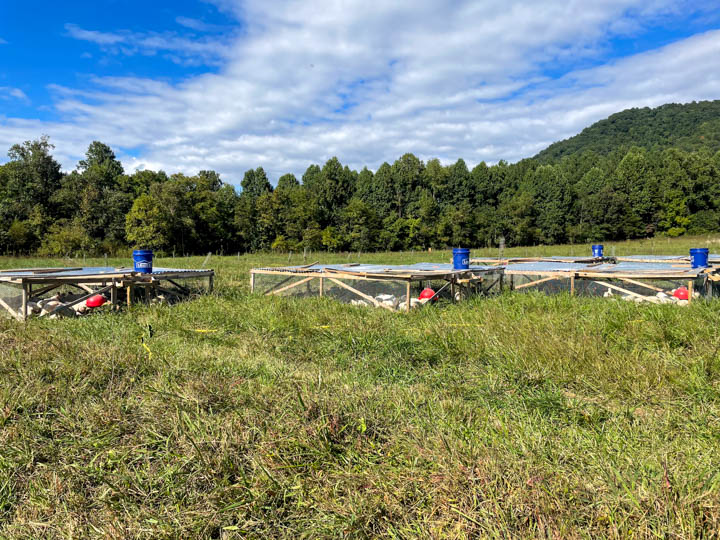
With the rise of the factory farming industry in America we took animals off the land where they were grazing, and moved them into factories.
Animals have been grazing naturally on the land for all of the world’s history and disrupting this has profoundly disrupted the world’s ecosystems and the natural regeneration of soil.
When we moved livestock into factories we separated them from the food they eat. So then what?
Then we need to use vast spaces of land solely for the purpose of growing animal feed (monocultures of corn and soy) and separate land for the purpose of keeping livestock.
Moving animals into factories served the goal of centralizing “meat production”, cutting costs and enabling the industry to more quickly fatten up animals for slaughter. But that action was and is short-sighted.
Grazing animals on the land provides a number of benefits:
- Provides natural fertilizer
- Leaves the roots of plants intact
- Hooves break up the soil, making it easier for water to permeate the ground
- Selective grazing opens up space for more plants to grow
2. Cover Cropping
Cover cropping involves planting specific plants on fields, often non-cash crops, during periods when the main crop is not actively growing.
This is in contrast to leaving the fields bare outside of the growing season. Little Pond Farm plants cover crops every year during the off season to protect and regenerate their top soil.
These cover crops serve multiple purposes: they protect the soil from erosion, suppress weeds, improve soil health by adding organic matter and enhancing nutrient cycling.
A farmer will carefully select cover crops to address the needs of the soil and ecosystem. For example, if an area had been planted with corn, which depletes the soil of nitrogen, once the corn is harvested the farmer might plant a cover crop of beans or clover, which put nitrogen back in the soil
The practice of cover cropping also helps maintain a landscape that is inviting to beneficial insects and microorganisms.
Cover cropping not only prevents soil degradation, it also rejuvenates it.
Cover cropping not only prevents soil degradation, it also rejuvenates it!
3. Crop Rotation
Crop rotation revolves around the idea that different crops have different nutrient requirements and interactions with pests and diseases.
Farmers that practice crop rotation will plant crops in different areas of their land each year.
By rotating crops, regenerative farmers break the cycle of specific pests and diseases, without relying on chemicals.
4. Crop Diversity
Crop diversity involves planting a wide variety of crops rather than relying on a single monoculture. Conventional agriculture often relies heavily on monocultures with entire swaths of agriculture land dedicated to a single crop. This is especially common with corn and soy.
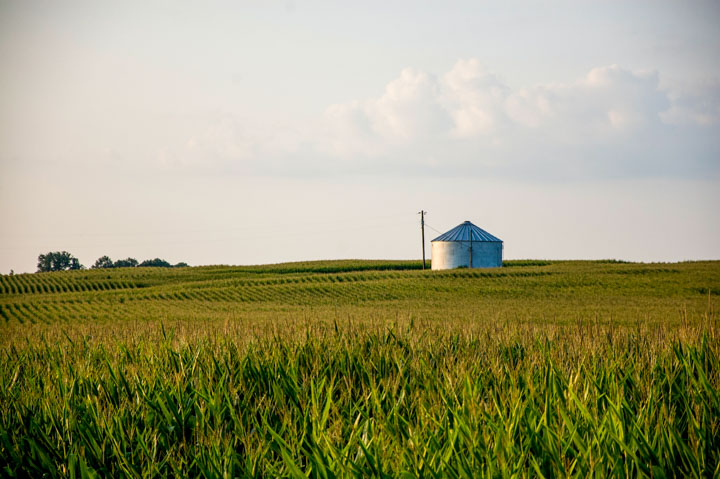
Different crops have unique nutrient requirements and growth patterns, and rotating or interplanting them can naturally improve soil fertility, reduce the need for chemical pesticides and fertilizers, and break pest cycles.
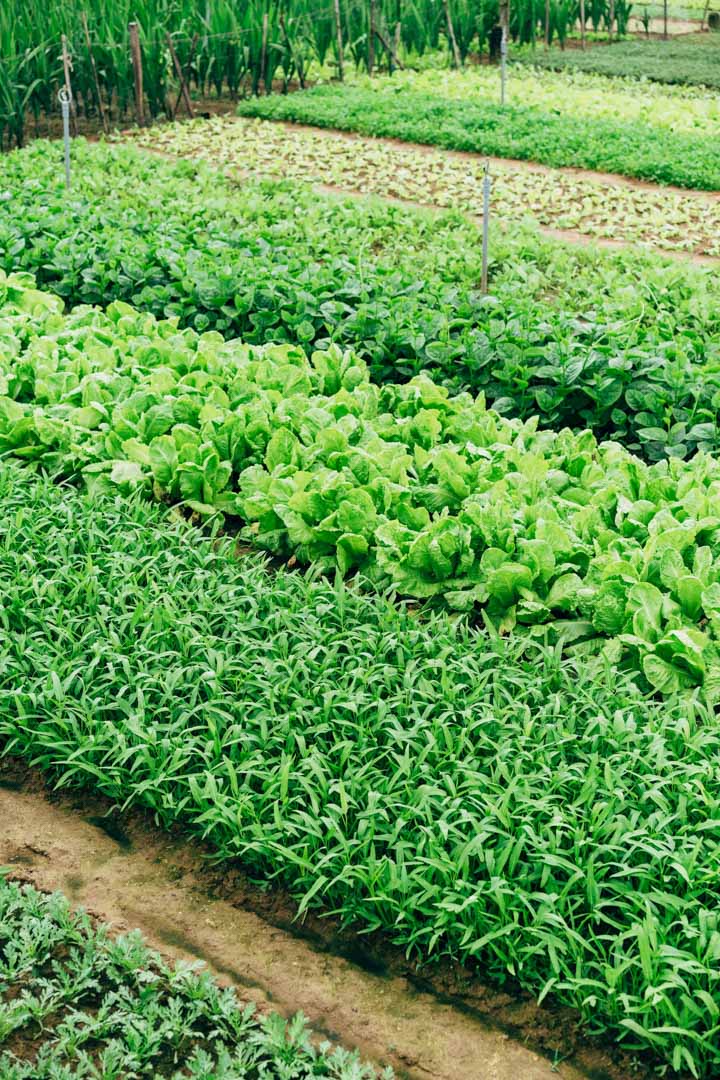
Additionally, diverse crops support a more varied community of beneficial insects and wildlife. By fostering crop diversity, regenerative agriculture not only strengthens the sustainability of farm land but also promotes greater resilience.
5. Minimize Chemical Inputs
Chemical inputs are synthetic fertilizers, pesticides and herbicides.
Instead, regenerative agriculture harnesses nature to manage pests, weeds and soil fertility. This principle not only reduces the environmental impact of farming, but also promotes the long-term health of the soil.
Certainly this soil-first approach takes more thought, time and consideration than just spraying the land to death. But I’ve witnessed it work in action. In fact, I talk to organic farmers every week at farmers markets who grow food without chemicals by working alongside mother nature.
6. Minimize Soil Disturbances (aka No-Till Farming)
No-till farming, also known as no-tillage or low-tillage farming, is an agricultural practice in which crops are grown without disturbing the soil through plowing or tilling.
Instead of turning over or breaking up the soil, no-till farming involves planting seeds directly into the untilled soil.
The residue from previous crops is left on the field to act as mulch, which helps prevent erosion, retain soil moisture, and improve soil structure. No-till farming aims to minimize soil disturbance and maintain the natural structure and organic matter content of the soil.
This practice offers several benefits, including:
- reduced soil erosion
- improved water conservation
- increased organic matter in the soil which enhances its health
- decreased fuel and labor costs compared to conventional tillage methods
No-till farming is a key component of regenerative and sustainable agriculture.
7. Agroforestry
Agroforestry is a principle of regenerative agriculture that involves the intentional planting of trees, shrubs, or woody perennials on the land. It combines agriculture (agro) with forestry.
In agroforestry, trees are strategically planted to complement crops and livestock. Trees provide:
- windbreaks to protect against erosion and harsh weather
- shade for livestock
- improved water retention through introducing more roots into the soil
- enhanced soil fertility through nutrient cycling
- habitat for beneficial wildlife and pollinators
By combining agricultural and forestry practices, agroforestry fosters greater biodiversity, promotes sustainable land use, and enhances the resilience of farm land in the face of environmental challenges.
8. Compost and Natural Fertilizer
Instead of synthetic fertilizers, regenerative farmers use organic materials such as compost, manure and green manure cover crops to enhance soil fertility. These materials release nutrients slowly, providing a sustainable source of nourishment for crops.
Compost and natural fertilizers differ in their composition and how they are created:
- Compost: Compost is a nutrient-rich, soil conditioner produced through the decomposition of organic matter such as kitchen scraps, yard waste, leaves, and other plant materials. The composting process involves the breakdown of organic materials by microorganisms like bacteria and fungi, along with the help of earthworms and other decomposers. Compost not only provides essential nutrients like nitrogen, phosphorus, and potassium to plants but also improves soil structure, moisture retention, and microbial activity. It is often used as a top dressing, incorporated into the soil, or mixed with potting soil to enhance plant growth.
- Natural Fertilizers: Natural fertilizers are derived from organic sources, such as animal manure, bone meal, fish meal, kelp, and other organic materials. These fertilizers contain essential plant nutrients in various proportions, depending on their source. For example, manure is rich in nitrogen, while bone meal provides phosphorus. Natural fertilizers are minimally processed and typically release nutrients slowly over time as they decompose, making them a sustainable choice for enhancing soil fertility. They can be applied directly to the soil or mixed into planting holes or rows to provide the necessary nutrients for plant growth.
Both compost and natural fertilizers are valuable tools in regenerative agriculture because they enrich the soil with essential nutrients, improve soil structure and enhance overall soil health.
Their use reduces the reliance on synthetic chemical fertilizers and supports environmentally friendly farming practices.
9. Water Management
Water management involves strategies and techniques to capture, store, and distribute water for agricultural purposes while minimizing waste and environmental impact.
Key components of water management in regenerative agriculture include rainwater harvesting for irrigation, contour farming, and the use of cover crops and mulch to reduce water runoff and erosion.
By optimizing water availability and minimizing water loss, regenerative agriculture practices not only ensure the health and vitality of crops but also help mitigate the effects of droughts and floods.
10. Conservation of Natural Habitats
The principle of conserving natural habitats is a cornerstone of regenerative agriculture, emphasizing the preservation and restoration of native ecosystems within and around farm land.
Regenerative farmers recognize the importance of these natural habitats as havens for beneficial insects, birds and other wildlife. By safeguarding these areas, regenerative agriculture not only enhances ecological balance but also promotes natural pollination and pest control services that benefit crops.
Moreover, the conservation of natural habitats helps prevent soil erosion, mitigates the impacts of extreme weather events, and supports the overall health and resilience of farming ecosystems.
This principle underscores the understanding that agriculture can coexist harmoniously with nature, contributing to the sustainability of both agricultural production and the broader environment.
11. Companion Planting
Companion planting is a gardening and farming practice that involves planting different types of plants near each other to achieve specific benefits, such as improved pest control, enhanced pollination, and increased crop productivity.
It is based on the concept that certain plant combinations can have mutually beneficial effects on growth and protection. Here are some common examples of companion planting strategies:
- Pest Control: Some plants naturally repel or deter pests, and planting them near vulnerable crops can help protect those crops. For instance, marigolds are known to repel nematodes, while garlic and onions can deter aphids and other insect pests.
- Attracting Beneficial Insects: Certain flowering plants, like lavender and dill, attract beneficial insects like ladybugs and parasitic wasps, which can help control pest populations by preying on them.
- Nitrogen Fixation: Legumes, such as beans and peas, convert nitrogen in the air into a form that other plants can absorb. This nitrogen is then released into the soil via special bacteria in their root nodules. Planting them near nitrogen-demanding crops like corn or tomatoes can provide a natural source of nitrogen fertilizer.
- Shade and Support: Taller plants can provide shade for shorter, more sun-sensitive crops. Additionally, tall, sturdy plants like corn can serve as support for vining crops like pole beans.
- Complementary Growth Patterns: Pairing fast-growing and slow-growing plants can maximize space and yield. For example, radishes can be planted alongside carrots. The radishes grow quickly and help break up the soil, making it easier for the slower-growing carrots to develop.
Companion planting is a sustainable and natural way to improve crop health and yield while reducing the need for chemical pesticides and fertilizers.
Successful companion planting requires knowledge of plant compatibility and careful planning to create harmonious plant communities that benefit each other in the garden or field.
12. Community and Knowledge Sharing
Fostering collaboration and knowledge exchange among farmers, researchers, and communities is integral to regenerative agriculture.
Knowledge sharing fosters a dynamic learning environment where traditional and modern farming practices, as well as scientific research, can intersect.
Farmers collaborate on implementing regenerative techniques, sharing successes and lessons learned. Researchers provide valuable insights into soil health, biodiversity, and ecosystem dynamics.
Local communities benefit from improved food systems, reduced environmental impacts, and increased resilience in the face of climate change.
Organic Farming vs Regenerative Farming
You may be wondering where organic farming fits into this conversation. Is regenerative farming better than organic farming? How is regenerative different from organic?
Organic agriculture and regenerative agriculture are related but distinct approaches to farming. Here are some key differences between the two:
1. Certification and Standards
- Organic Agriculture: Organic farming is a well-established and regulated system with defined certification standards. To be labeled as organic, farms must adhere to specific guidelines regarding the use of synthetic chemicals, GMOs and organic inputs.
- Regenerative Agriculture: Regenerative agriculture is a more flexible and holistic approach that focuses on principles rather than strict rules or certifications. While regenerative farmers often embrace organic practices, regenerative agriculture is not tied to a specific certification or set of standards.
2. Soil Health
- Organic Agriculture: Organic farming emphasizes soil health by avoiding synthetic pesticides and fertilizers. It encourages the use of organic matter and compost to enhance soil fertility.
- Regenerative Agriculture: Regenerative farming goes beyond organic by actively seeking to improve soil health through practices like no-till farming, cover cropping, and crop rotation. It aims to regenerate and rejuvenate degraded soils.
3. Ecosystem Focus
- Organic Agriculture: Organic farming primarily focuses on avoiding synthetic chemicals and promoting organic inputs while adhering to specific rules.
- Regenerative Agriculture: Regenerative farming takes a broader ecosystem approach, aiming to create resilient agricultural systems that support biodiversity, water conservation and carbon sequestration.
4. Approach to Pest Control
- Organic Agriculture: Organic farming uses approved organic pesticides when necessary for pest control while avoiding synthetic chemicals.
- Regenerative Agriculture: Regenerative agriculture often employs integrated pest management (IPM) strategies, emphasizing the use of natural predators and fostering biodiversity to control pests.
5. Flexibility and Adaptation
- Organic Agriculture: Organic farming follows established standards, which can limit flexibility and adaptation to local conditions.
- Regenerative Agriculture: Regenerative practices can be tailored to specific ecosystems and local needs, allowing farmers to adapt and innovate more freely.
6. Carbon Sequestration
- Organic Agriculture: While organic farming can contribute to carbon sequestration through improved soil health, it may not have the same explicit focus on carbon as regenerative agriculture.
- Regenerative Agriculture: Regenerative farming often prioritizes carbon sequestration as a core goal, aiming to capture and store atmospheric carbon in soils through practices like no-till farming and cover cropping.
As you can see, while organic agriculture and regenerative agriculture share some common principles, regenerative agriculture takes a more holistic and flexible approach with a specific emphasis on soil health, ecosystem regeneration, and carbon sequestration.
Organic farming, on the other hand, adheres to established certification standards and focuses primarily on avoiding synthetic inputs. Some farmers may choose to integrate both approaches, combining organic practices with regenerative principles to create sustainable and resilient farming systems.
I think of organic regenerative farming as the gold standard. Farms that use organic practices AND regenerative practices are the ones I prioritize buying from at farmers markets.
The Future of Farming
Regenerative agriculture is not just a buzzword; it’s a practical and holistic approach to farming that addresses some of the most pressing challenges of our time.
By focusing on soil health, carbon sequestration, and sustainable practices, regenerative farms are proving that it’s possible to produce abundant and nutritious food while also preserving the health of our planet.
As the benefits of regenerative agriculture become increasingly evident, it’s clear that this approach is not only the future of farming but also a key component of a more sustainable agriculture industry.
Common Ground Documentary
I recently attended a screening of the Common Ground documentary film. If you’re interested in learning more about regenerative agriculture I highly recommend checking out the film if it’s showing in your city. You can see a list of theaters and showtimes on their website.
The film explores how regenerative agriculture can help heal the soil, our health and the planet. It provides concrete ways we can fix our broken food system, and real examples of regenerative farms seeing abundance next to industrial farms seeing devastation.
It’s an inspiring movie and I highly recommend it. Watch the official trailer for Common Ground here.

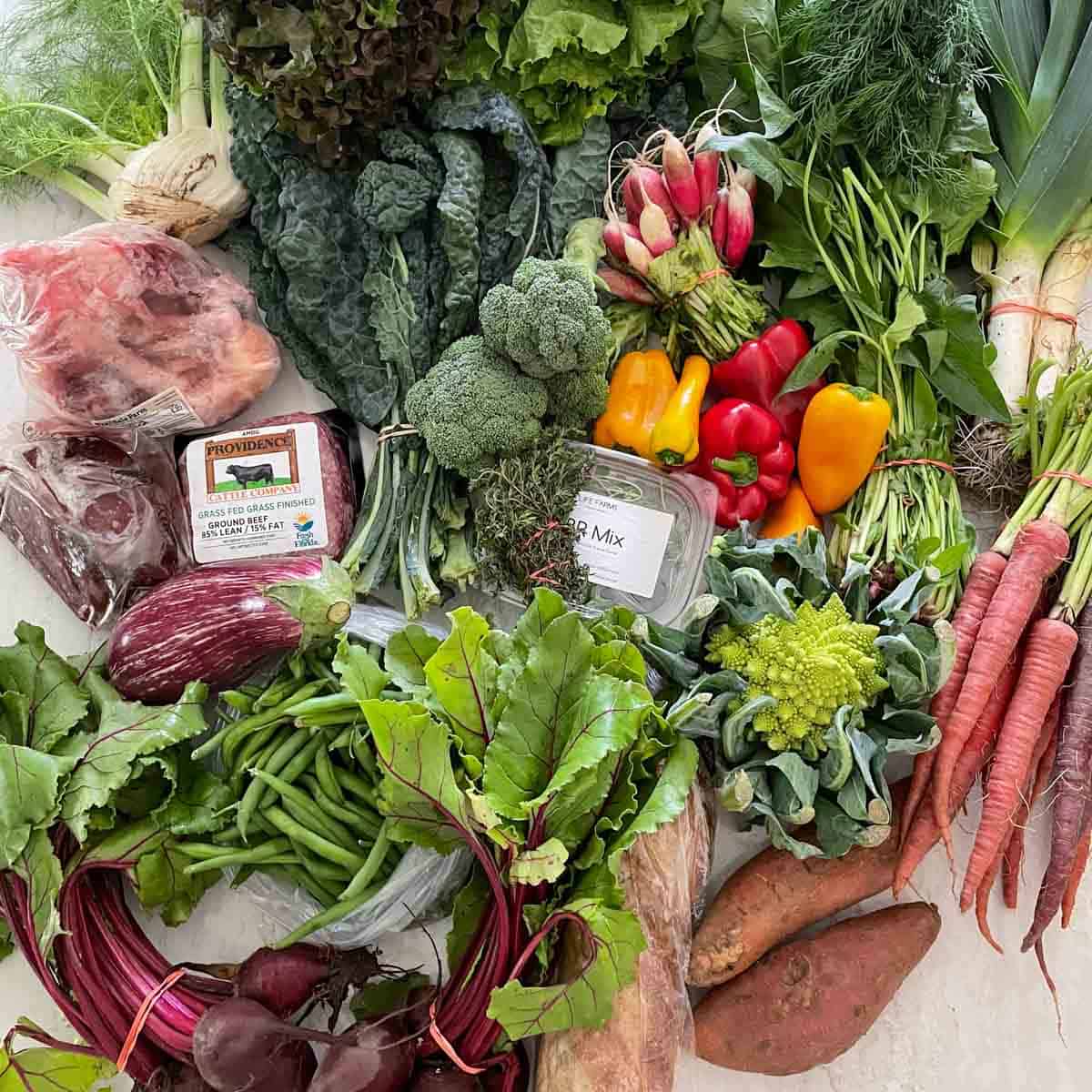






Leave a Reply